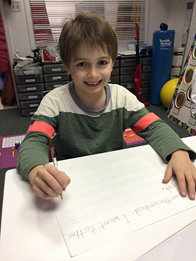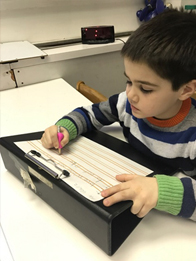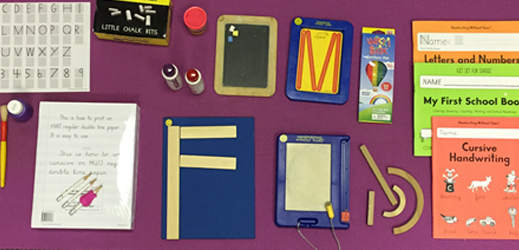Teaching Handwriting at Aaron School the “No Tears” Way
Teaching students how to write is an important component of any school’s curriculum. Here at Aaron School, all of our students learn how to write using the Handwriting Without Tears (HWT) program. Handwriting Without Tears is a research-based, multi-sensory, and developmentally sequenced handwriting curriculum created by two Occupational Therapists, Jan Z. Olsen (Occupational Therapist Registered, OTR) and Emily F. Knapton (OTR). The curriculum is designed to correlate with a child’s developmental milestones.
Developmentally, children first learn to imitate, copy, and finally write independently. Letters are grouped together and taught in a sequence that derives from their similar characteristics. For example, the program does not begin with capital letter A, but rather begins with “frog jump” capitals, then goes on to “starting corner” capitals, and ends with “center starting” capitals. The language used remains consistent throughout the entire pre K to 5th grade curriculum. (ex: big line, little line, magic “c”).
Capital Teaching Order
Developmentally, capitals are easier so we teach them first. The capital teaching order
helps teach correct formation and orientation while eliminating reversals. Learning
capitals first makes it easy to transition to lowercase letters.

Lowercase Teaching Order
We teach lowercase c, o, s, v, and w first because they are exactly the same as their capital
partners, only smaller. By teaching capitals first, we have prepared children for nearly half of
the lowercase letters that are similar in formation.

You can access it anywhere:
App: Wet, Dry, Try: Allows users to practice stroke sequences for uppercase and lowercase print letters as well as numbers. Each letter or number requires the child to master three levels of that letter/number. As the child progresses through the levels, the amount of verbal and visual cues in addition to the deviations allowed from the correct stroke decrease as mastery of each letter/number increases.
Online Resources/Printables:
After creating a username and password on http://www.hwtears.com/, parents and educators can access a wide variety of online resources. The A+ Worksheet Maker Lite, allows users to create both print and cursive practice worksheets. There are also additional downloads and printables about curriculums and letter formation sequences to assist your child at home. Digital Teaching Tools provides another multi-sensory way to explore and practice handwriting through interactive whiteboards or computers. Finally, there are many videos demonstrating lessons and teaching strategies for handwriting as well as webinars addressing handwriting topics.
Why we love it:
The curriculum is designed to be both adult and kid friendly. Multi-sensory tools such as wooden sticks (+ cards), play-doh (+ cards), chalk boards, chalk, sponges, small pencils, and original songs about handwriting are all woven into the HWT lessons. The program encourages creativity and incorporates foundational skills into the curriculum such as body awareness, spatial awareness, pencil grip, and finger isolation. While the ultimate goal is legible letter production on lined paper, teachers are encouraged to think outside the box! Students may use their whole body to walk on a gigantic letter taped to the floor or perhaps they will trace a variety of letters in shaving cream. The possibilities are endless!




